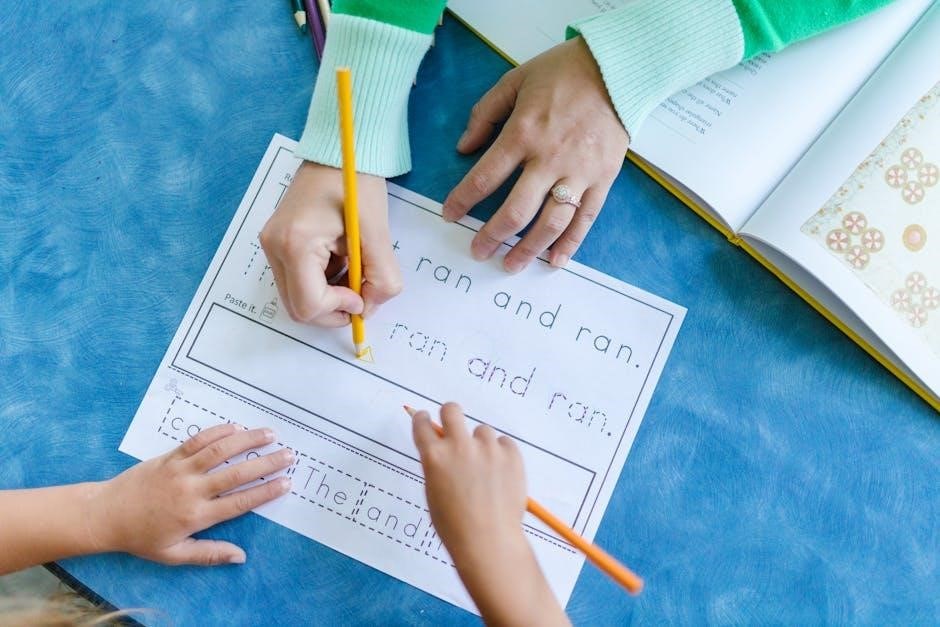
Kindergarten workbook PDFs are educational tools designed to support early learning through structured activities․ They cover reading, writing, math, and problem-solving, preparing young children for formal education while fostering cognitive and motor skills development․
1․1 What Are Kindergarten Workbooks?
Kindergarten workbooks are interactive learning tools designed for young children, typically in PDF format․ They include activities focused on reading, writing, math, and problem-solving, providing a structured approach to early education․ These workbooks are often printable and aligned with curriculum goals to support foundational skills development in a fun and engaging way․
1․2 Importance of Using Workbooks for Early Learning
Workbooks play a crucial role in early learning by providing structured activities that enhance foundational skills․ They help children develop reading readiness, math concepts, and problem-solving abilities while fostering a love for learning․ With engaging exercises, workbooks prepare young minds for formal education and support parents and educators in creating a nurturing learning environment․
Benefits of Kindergarten Workbook PDFs
Kindergarten workbook PDFs offer foundational knowledge, enhancing learning readiness through interactive activities that build essential skills like letter recognition, counting, and problem-solving in a structured format․
2․1 Development of Cognitive Skills
Kindergarten workbook PDFs are designed to enhance cognitive skills through engaging activities․ They include matching, counting, and sequencing exercises that improve memory, concentration, and logical thinking․ These structured tasks help children develop problem-solving abilities and critical thinking, laying a strong foundation for future academic success․
2․2 Enhancement of Motor Skills
Kindergarten workbook PDFs often include activities that enhance motor skills, such as tracing letters, coloring, and puzzles․ These exercises improve hand-eye coordination and dexterity, preparing children for writing and using tools effectively․ Worksheets like those from Teachers Pay Teachers and Edmentum Exact Path provide engaging ways to develop these essential physical abilities through fun, structured tasks․
2․3 Preparation for Formal Education
Kindergarten workbook PDFs introduce young learners to structured activities that ease the transition to formal education․ They familiarize children with classroom routines, basic concepts, and essential skills, ensuring readiness for grade school․ These resources bridge the gap between play-based learning and academic expectations, fostering confidence and a strong foundation for future success․
Structure of a Typical Kindergarten Workbook PDF
A typical kindergarten workbook PDF includes reading readiness, early math concepts, and problem-solving exercises․ These structured activities promote learning and skill development in young children effectively․
3․1 Reading Readiness Activities
Kindergarten workbook PDFs include reading readiness activities like letter recognition, phonological awareness, and basic sight word exercises․ These exercises are designed to introduce young learners to the fundamentals of reading, fostering a strong foundation for future literacy skills through engaging and interactive tasks․
3․2 Early Math Concepts
Kindergarten workbook PDFs introduce foundational math skills, focusing on counting, basic number recognition, and shape identification․ Activities include matching objects to numbers, identifying patterns, and understanding simple addition and subtraction․ These exercises are designed to be engaging and visual, helping young learners build a strong math foundation through interactive and fun tasks․
3․3 Problem-Solving Exercises
Problem-solving exercises in kindergarten workbooks include activities like matching objects, sequencing events, and completing puzzles․ These tasks enhance logical thinking and critical reasoning skills, preparing children to tackle more complex challenges in their educational journey․ Interactive and engaging, these exercises often feature colorful illustrations and step-by-step guidance to foster independence and confidence․

Popular Types of Kindergarten Workbook PDFs
Popular types include math-focused, reading, and mixed-subject workbooks․ They cover essential skills like counting, letter recognition, and problem-solving, catering to diverse learning needs and interests․
4․1 Math-Focused Workbooks
Math-focused kindergarten workbooks emphasize early numerical skills, such as counting, basic addition, and subtraction․ They include activities like number tracing, shape recognition, and simple problem-solving to build foundational math concepts․ These workbooks often align with curriculum goals, providing engaging exercises to prepare children for more complex math in higher grades while fostering logical thinking․
4․2 Reading and Writing Workbooks
Reading and writing workbooks focus on foundational literacy skills, such as letter and sound recognition, alphabet tracing, and basic sentence formation․ Activities include word matching, rhyming games, and simple writing exercises, helping children build confidence in reading and writing abilities while fostering a love for language and storytelling․
4․3 Mixed Subject Workbooks
Mixed subject workbooks combine multiple areas of learning, such as math, reading, and problem-solving, into one comprehensive resource․ These PDFs offer a variety of activities, blending letter tracing, basic arithmetic, and color recognition to provide a well-rounded educational experience for young learners, keeping them engaged and curious about different subjects․
Skills Covered in Kindergarten Workbook PDFs
Kindergarten workbook PDFs focus on letter and sound recognition, basic counting, color and shape identification, reading readiness, and foundational math skills for young learners․
5․1 Letter and Sound Recognition
Kindergarten workbook PDFs often include activities that introduce children to letters and their corresponding sounds, enhancing phonetic awareness․ These exercises may involve tracing letters, matching games, and identifying beginning sounds in words․ Such tasks help build foundational reading skills and prepare children for more complex literacy challenges in later grades․
5․2 Basic Counting and Number Skills
Kindergarten workbook PDFs often include activities that introduce basic counting and number recognition․ These exercises help children understand numerical concepts, such as identifying numbers 1-100, counting objects, and simple addition․ Worksheets may feature sequences, matching games, and interactive problems to make learning engaging and foundational for future math skills․
5․3 Color and Shape Identification
Kindergarten workbook PDFs often include activities that help children recognize and identify basic colors and shapes․ These exercises, such as matching games and coloring tasks, enhance visual recognition and cognitive development․ They introduce foundational concepts like red, blue, and green, as well as shapes like circles, squares, and triangles, fostering creativity and problem-solving skills․
How to Choose the Right Kindergarten Workbook PDF
Choosing the right kindergarten workbook PDF involves aligning it with curriculum goals, ensuring age appropriateness, and selecting content that engages young learners effectively, fostering foundational skills and supporting their educational journey․
6․1 Aligning with Curriculum Goals
Choosing a workbook that aligns with curriculum goals ensures it supports educational standards․ Look for resources that cover key areas like reading readiness, math concepts, and problem-solving, as seen in popular workbooks from Teachers Pay Teachers and Bridges in Mathematics, designed to match curriculum needs and promote skill mastery effectively․
6․2 Age Appropriateness
_kindergarten workbook PDFs should align with the developmental stage of children aged 5-6, offering activities that match their cognitive and motor abilities․ Worksheets should feature clear visuals, simple language, and engaging tasks to ensure effectiveness and enjoyment․ Age-appropriate content fosters independence and confidence while introducing foundational skills like letter tracing or basic math problems․
6․3 Engagement and Fun Factor
Engagement and fun are crucial for young learners․ Kindergarten workbook PDFs often include colorful, interactive activities and creative exercises that make learning enjoyable․ Games, puzzles, and hands-on tasks help maintain children’s interest while fostering their educational development in an entertaining and motivating way․

Digital vs․ Printable Kindergarten Workbook PDFs
Digital workbooks offer accessibility and interactivity, while printable versions provide a tactile learning experience․ Both formats cater to different learning preferences and environments, enhancing flexibility for young learners․
7․1 Advantages of Digital Workbooks
Digital workbooks offer convenience and accessibility, allowing children to learn anywhere․ They often include interactive features like animations and audio, enhancing engagement․ Digital versions are space-saving, easily shareable, and frequently free, making quality education accessible to all․ They also reduce the need for physical materials, promoting a modern, eco-friendly learning experience․
7․2 Benefits of Printable Workbooks
Printable kindergarten workbooks offer flexibility, allowing parents and teachers to print only needed pages․ They are ideal for offline learning, reducing screen time․ Many free resources, like those from Teachers Pay Teachers, provide cost-effective solutions․ Printable workbooks promote hands-on learning, making them perfect for classroom or home use, and are easily adaptable to individual learning pacing․
Integrating Workbook Activities into Daily Learning
Consistency is key; incorporate workbook activities into daily routines to reinforce learning․ Involve parents to ensure activities align with curriculum goals and promote a structured, engaging environment․
8․1 Setting a Daily Routine
Establishing a consistent daily routine helps young learners stay focused and engaged․ Allocate specific times for reading, math, and problem-solving activities․ Keep sessions short to maintain attention and ensure activities are fun and interactive․ Incorporate workbook exercises into the routine to develop a structured learning habit․ Positive reinforcement and breaks encourage steady progress and overall development․
8․2 Encouraging Parental Involvement
Parental involvement is crucial for maximizing the benefits of kindergarten workbook PDFs․ Parents can guide their children through activities, providing support and positive feedback․ Resources like Teachers Pay Teachers offer interactive worksheets that parents can download and use to engage their kids in learning․ This collaboration fosters a strong educational foundation and strengthens parent-child bonding․

Tips for Using Kindergarten Workbook PDFs Effectively
Ensure activities are engaging and fun, involve parents in practice, and provide constructive feedback to foster confidence and steady progress in young learners․
9․1 Providing Positive Feedback
Positive feedback is essential for fostering confidence in young learners․ Use kindergarten workbook PDFs to highlight progress, praise effort, and celebrate milestones․ Specific, encouraging comments or stickers can motivate children to embrace challenges and enjoy the learning process, creating a positive association with education from an early age․
9․2 Monitoring Progress
Monitoring progress in kindergarten workbook PDFs helps track a child’s skill development․ Regularly reviewing completed activities provides insights into mastery of concepts like counting or letter recognition․ This allows parents and educators to identify areas needing reinforcement, ensuring a tailored learning experience that supports continuous growth and understanding․
Free Kindergarten Workbook PDF Resources
Popular platforms like Teachers Pay Teachers offer free kindergarten workbook PDFs․ Examples include “Workbook I Kindergarten I Reading & Writing” and “Kindergarten Worksheet Bundle: Volume Two․”
10․1 Websites Offering Free Downloads
Websites like Teachers Pay Teachers, Worksheet Fun, and Edmentum Exact Path offer free kindergarten workbook PDFs․ These platforms provide a variety of printable math, reading, and literacy worksheets, along with activities for counting, problem-solving, and early learning skills, making them valuable resources for parents and educators seeking affordable educational materials․
10․2 Examples of Popular Free Workbooks
Popular free kindergarten workbooks include “Kindergarten Worksheet Bundle: Volume Two” and resources from Teachers Pay Teachers․ These PDFs offer printable math, reading, and literacy activities, covering skills like counting, letter recognition, and problem-solving․ They align with curriculum goals and provide engaging practice for young learners․

Creating Custom Kindergarten Workbook PDFs
Custom kindergarten workbook PDFs can be designed using tools like Canva or Adobe Illustrator, allowing educators to tailor content to specific learning needs and preferences․
11․1 Tools for Designing Workbooks
Canva, Adobe Acrobat, and Google Docs are popular tools for designing kindergarten workbooks․ They offer templates, editing features, and collaboration options, making it easy to create engaging and educational content for young learners․
11․2 Tailoring Content to Individual Needs
Customizable kindergarten workbook PDFs allow educators to adapt activities based on a child’s learning pace and style․ Tools like Edmentum Exact Path and Reading Eggs provide flexible templates, enabling teachers to create personalized worksheets that address specific skill gaps, ensuring each child receives targeted support for their developmental needs․
Best Practices for Using Workbook PDFs
Balance workbook activities with play to ensure well-rounded development․ Encourage creativity and critical thinking while using workbooks to foster a love for learning in young children․
12․1 Balancing Workbook Use with Play
Combining workbook activities with play ensures a well-rounded learning experience․ Activities like puzzles, building blocks, and art enhance creativity and motor skills, preventing monotony․ Regular breaks and playful engagement foster a love for learning while maintaining focus and enthusiasm in young children․
12․2 Encouraging Creativity
Kindergarten workbook PDFs often include open-ended activities that spark creativity, such as drawing, storytelling, and imaginative puzzles․ These exercises allow children to express their thoughts freely, fostering innovation and confidence while learning foundational skills․ Interactive and engaging tasks help develop creative thinking, making learning enjoyable and meaningful for young minds․ Creativity is nurtured through fun, hands-on experiences․